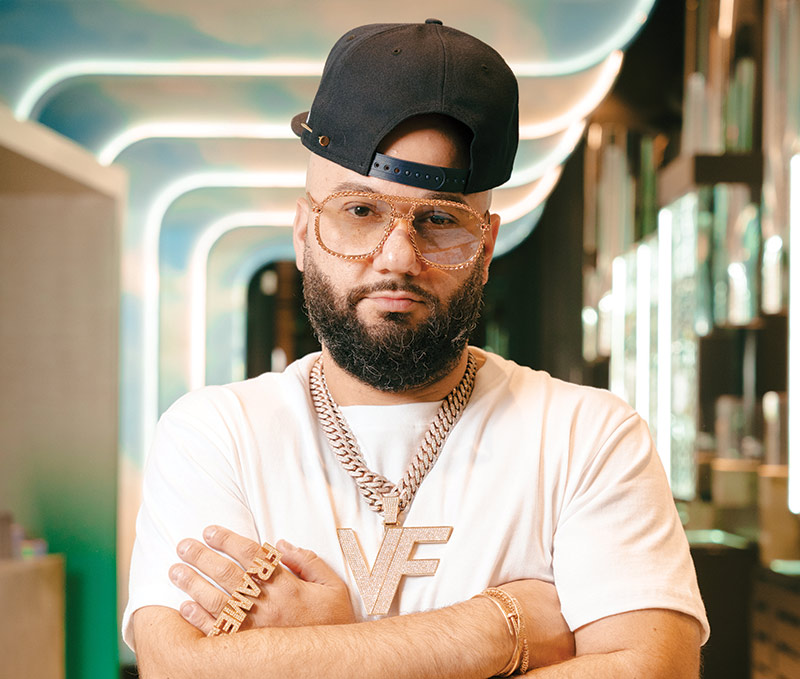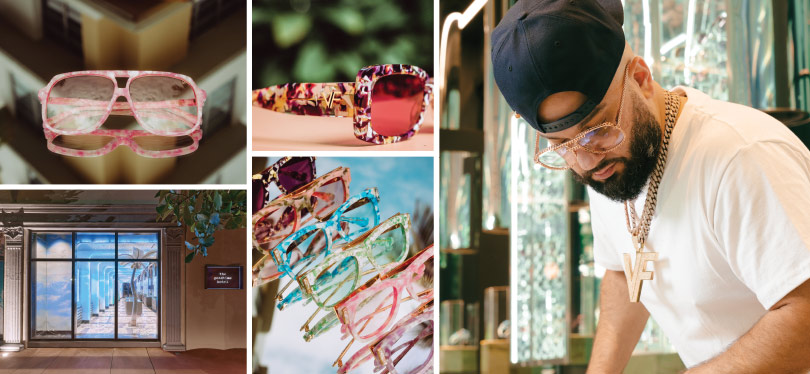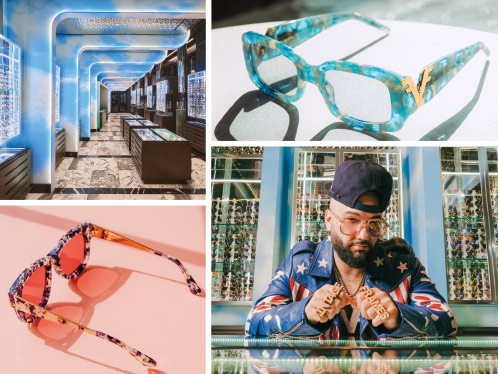OPTICAL INDUSTRY, IT’S TIME TO OPEN YOUR EYES AND MAKE ROOM FOR VINTAGE FRAMES COMPANY CEO COREY SHAPIRO AS HE DISCUSSES HIS BRAND’S TRAJECTORY WITH FEATURE EDITOR JILLIAN URCELAY

If you have not heard the name Corey Shapiro yet, let me quickly fill you in because I can guarantee you will not be forgetting it anytime soon. His personality is electric. He has one of the biggest personal followings in the industry, with over 242,000 Instagram followers. And most impressively, he has amassed the largest collection of vintage eyewear in the entire world. So allow me to get you acquainted with the man behind Vintage Frames Company.
Founded in 2008, Vintage Frames Company was born with the main objective of preserving the fashion history of optical. Shapiro and his team began by traveling the globe collecting “dead stock,” or unworn vintage eyewear pieces dating back from the 1950s to early 2000s. After purveying over a million frames, Shapiro had put together the most comprehensive collection of pure market vintage ever. The company quickly became wildly popular in pop culture becoming the go-to spot for vintage eyewear—not only because they had the inventory but also because they were educating their customers. Shapiro’s clients, which include names like Jay-Z, Lady Gaga and Diddy, could be sitting next to Anna Wintour at a runway show and give her a history lesson on the piece. It has always been vitally important for Shapiro and his team to educate and spread fashion history wherever possible.
Shapiro will be the first to tell you he is not a “professionally trained optical industry gentleman.” His path was a little different. The Montreal native went to fashion school, studying fashion history and originally worked his way up as a major part of the time’s emerging sneaker culture. Being a part of the sneaker trading community, he made connections throughout the world accruing a reputation in collectible fashion culture. While he was successful in the sneaker biz, he saw its limitations, realizing eyewear was the lucrative market he had always been looking for.
Vintage Frames Company’s early goal was simple, and it focused on the idea that fashion always comes back into full cycle. “Let’s say the ’70s were re-popularized into culture at the time, we would have frames from the ’70s but we would also be buying eyewear from the early 2000s, anticipating that it would roll through the ages and eventually get there,” Shapiro explains. The company’s clientele was so powerful that as soon as a celebrity wore a product, everyone in the world wanted that same frame. The problem? Because Shapiro was selling pure market vintage, and it was not contrived hype, there was no telling whether that viral frame was the last one that existed on Earth. It became hard to capitalize on the type of product he was working with.

Shapiro’s next step? He began approaching eyewear companies to reteach them their lineage. He did special collaborative projects with brands like Cazal, but he knew he needed to do more. The company doubled back to its digging ways and started collecting vintage machinery and tooling from old factories. They created their own factory teaching the craftsmen how to use the old machines. It was time to start their own line to recreate the classics in the most accurate way possible while mixing in cultural references of today to create timeless pieces. In 2018, Vintage Frames Company released its first frame, the Detroit Player, and it was a massive success. With that triumph, Shapiro added a new title to his name—in addition to CEO and founder, he was now an eyewear designer.
It was only natural for Shapiro to begin producing and designing his own collection. He believes there is not a single person in the industry that has touched more individual SKUs of eyewear than he has. And he isn’t saying that in a boastful way, it’s simply the sheer amount (let me remind you, over 1.5 million) of vintage frames he has purveyed. Because of that, he is at the helm of every piece of eyewear his company produces from designs, to colors to style names. “I have seen what has performed and what has not performed based on what’s left over in back stocks. What has lasted the test of time, what has decayed. I think educationally, from a historic point of view in optical, very few people can touch my understanding of it,” he says. “Most people will have really good knowledge into one brand. But because I don’t come from the brand side of things, Vintage Frames really takes different inspirations from construction and pays homage to different elements within historic eyewear. I have such a clear, concise interest on preserving the historical portion of the production that it would be hard to even teach someone unless there was someone that was passionate about it like me. And since it’s fairly odd, kind of all-encompassing and just really out of the ordinary—I haven’t really found that person.”
Eyewear has intrigued Shapiro since he was a child, especially from a music standpoint. His mixtapes and CDs would play Elton John to Wu-Tang Clan, back to the Notorious B.I.G., and then Billy Idol and Phil Collins. His musical genres were eclectic but he always admired the energy that sunglasses brought to the table when artists were performing. “I always thought there was this very interesting philosophy that was unspoken, which was by putting a barrier between your eyes and the rest of the world, you were adding an extra layer of confidence that most people didn’t have,” he says. He looked at where the industry was heading in the early 2000s—lighter, thinner and more dynamic, and he wanted to switch things up. To him eyewear was not fun anymore. It lost its spark; it wasn’t exciting. “Where’s the stones, where’s the runway editorial on the street?” he wondered.
Shapiro created what he felt was missing from today’s offering. “We have this over-the-top type of perspective where we bring people into our world, and there’s really nothing like it in the optical industry. When the optical industry goes left, we just happened to be walking right,” he says. “And not because we’re necessarily trying to be different. We just are different. We jump to our own beat. We do things our own way. We’re very aggressive. We’re very outlandish.”

When Shapiro designs something—he believes in it, he will produce it and put it into stock. “At any given time, we have 500 to 600 different SKUs of unreleased eyewear that people have never even seen. So if we need to react to culture, what’s going on in the world, or we need to cause a ruckus, we can be in market in minutes.” As you can assume, this isn’t the norm. “By the time other companies can even figure out how to produce it, let alone market it, we are already sold out. We’ve been sold out for months, and we are on our way to something else.”
Shapiro also does things differently when it comes to frame design and his philosophy. Vintage Frames Company does not design for specific genders or sexes, he just wants to make customers look good. Quality and construction are the number one priority. Next is the size of the frame. They do not make small sizes. “The very unique mentality of my company and our brand guide is that frames are not meant to fit your face, they’re meant to fit your personality,” he explains. “As you walk in the door, one of our specialists, including myself, already has an idea of what you’re meant to jump into based on what your confidence is.” Shapiro wants his frames to make a statement, and he truly puts his customers’ wants and needs into consideration. “A lot of our clientele are wearing glasses at night, as well,” he says. “So we’ve considered that in our full frame production and in all of our lenses. You can wear them indoor or outdoor, and really grab people’s attention. Even on the lens front, the base curves we use are flatter. The materials we use are heavier. We don’t want stuff to be lighter. We want you to feel that it’s on your face.”
Frame design begins with styles in the signature collection and focuses on the main silhouettes. Frames are constantly reworked creating new models using the same frame front but switching up the temples, adding in different materials and bringing in pop culture elements. They start customers at an attainable price point to find their best style, usually from the signature series. Once a customer is a fan of a particular style, they can collect the entire collection, which is quite vast. “We might sell glasses to the Prince of Bahrain and Jay-Z, and we might sell them $100,000 of glasses at a time. But if you want to come in because you saved up $125 to buy our entry level price point, you’re going to get the same quality service and the same quality of glasses as you would if you were spending $100,000. That is so important to us,” says Shapiro.
Vintage Frames Company currently has two stores, its flagship in Montreal and a newly opened location in Miami. Shapiro’s goal is to make visiting his stores a complete experience. He wants you to walk in and feel like you are somewhere you have never been before—a completely over-the-top and all-encompassing kind of experience. The stores carry an equal mixture of Shapiro’s own production and actual commodity vintage. Customers can see the vast array of models that he creates in a drop culture type of format, but they can also run through the lineage of the inspiration behind those frames, while touching, feeling and purchasing them as well. “It doesn’t matter if you’re 90 years old, and you wore the frames in 1970, or if you’re the granddaughter, and you’re 14 years old. It’s equally as exciting and emotional of an experience for everyone.”
In late 2022, Vintage Frames Company opened its doors to its first U.S. store in Pharrell William’s The Goodtime Hotel in Miami. This was a full circle moment for Shapiro as Pharrell, who was recently named Louis Vuitton’s men’s creative director, played a major role in helping the brand grow. “Every single interaction with him is always special. It’s very pure. Each and every single time we’ve met in any capacity at that very moment he’s changed events, the trajectory of my life and this brand. And never for any other reason than because he’s a kind gentleman that when he loves something, he does it just out of selfless love.”
After working tirelessly for two years, Shapiro’s Miami vision came to life. “I knew we really had to come out swinging for this full circle culmination moment,” he says. “The level of execution of our retail and the detail that’s put into it from the buildout, to the selection with bespoke, even down to the scent is unmatched.” Hundreds of fans waited in line on opening day to shop. People flew in from all over the world to support and be seen. And Shapiro jokes, “Where better to sell glasses than in Miami? If you can’t sell sunglasses in Miami, you kind of f--ked up.”
He is not stopping in Miami—the next goal is to open more stores throughout the U.S. “A lot of brands want flagships in New York or Los Angeles, and they think there’s a prestige to that, which is cool, but that’s not really our thing,” he explains. “What about Atlanta or North Carolina, places like that, they’re dying for experiences.” Shapiro wants to make sure that if you’ve visited a Vintage Frames store and travel to their location in another city, you know that you’re walking into a completely different environment. He believes each store should be its own world so the customer will want to visit every single retail store to experience what the company has to offer.
Shapiro knows he is the outlier in the eyewear industry. He acknowledges that he looks much different than the average optical professional. He wears big chains, a backwards hat and huge rings. “If the Wu-Tang Clan and Elton John had a kid, I’m that kid,” he laughs. “We just try to do something that’s super fresh and inviting, and not take ourselves too seriously. We don’t feel like we have anything to prove to ourselves or to anyone else. We’ve proved it and now we want to support the places that support us in a big way. We want to go after markets that are different. People are going to really have to step their whole optical experience up because consumers don’t want that same archaic way of looking at things.”
Vintage Frames Company is making eyewear exciting again. It is offering something different to the market. “We’ve made it so that eyewear is collectable. Because we don’t go in at such a high price point, we allow people to consume and collect,” he says. “Instead of making it impossible to be a vintage frames collector, we empower people to be able to do that. That’s been the success of how we do things and how out of left field we’ve come.”
Shapiro’s customers, from the biggest names in the world to the everyday guy walking down the street in Montreal, are buying what he’s selling. Frankly, it is hard not to root for Corey Shapiro. He’s easy to believe in. He knows his stuff. And he is on his way to disrupting the eyewear industry as we know it. ■










